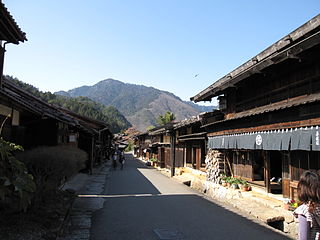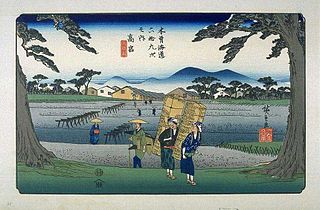
The Tōkaidō Main Line is a major Japanese railway line of the Japan Railways Group network, connecting Tokyo and Kōbe stations. It is 589.5 km (366.3 mi) long, not counting its many freight feeder lines around the major cities. The high-speed Tōkaidō Shinkansen largely parallels the line.

The Nakasendō, also called the Kisokaidō (木曾街道), was one of the five routes of the Edo period, and one of the two that connected Edo to Kyoto in Japan. There were 69 stations (staging-posts) between Edo and Kyoto, crossing through Musashi, Kōzuke, Shinano, Mino and Ōmi provinces. In addition to Tokyo and Kyoto, the Nakasendō runs through the modern-day prefectures of Saitama, Gunma, Nagano, Gifu and Shiga, with a total distance of about 534 km (332 mi).

Nihonbashi is a business district of Chūō, Tokyo, Japan which grew up around the bridge of the same name which has linked two sides of the Nihonbashi River at this site since the 17th century. The first wooden bridge was completed in 1603. The current bridge, designed by Tsumaki Yorinaka and constructed of stone on a steel frame, dates from 1911. The district covers a large area to the north and east of the bridge, reaching Akihabara to the north and the Sumida River to the east. Ōtemachi is to the west and Yaesu and Kyobashi to the south.

Magome-juku was the forty-third of the sixty-nine stations of the Nakasendō connecting Edo with Kyoto in Edo period Japan. It is located in former Mino Province in what is now part of the city of Nakatsugawa, Gifu Prefecture, Japan. It was also the last of eleven stations along the Kisoji, which was the precursor to a part of the Nakasendō, running through the Kiso Valley.

The Five Routes, sometimes translated as "Five Highways", were the five centrally administered routes, or kaidō, that connected the de facto capital of Japan at Edo with the outer provinces during the Edo period (1603–1868). The most important of the routes was the Tōkaidō, which linked Edo and Kyoto. Tokugawa Ieyasu started the construction of these five routes to increase his control over the country in 1601, but it was Tokugawa Ietsuna, the 4th shōgun of the Tokugawa shogunate and Ieyasu's great-grandson, who declared them as major routes. Post stations were set up along the route for travelers to rest and buy supplies. The routes thrived due to the policy of sankin-kōtai, that required the daimyō to travel in alternate years along the routes to Edo.

Tsumago-juku was the forty-second of the sixty-nine post towns on the Nakasendō. It is located in Nagiso, Kiso District, Nagano Prefecture, Japan. It has been restored to its appearance as an Edo-era post town and is now a popular tourist destination.
The Fifty-Three Stations of the Tōkaidō, in the Hōeidō edition (1833–1834), is a series of ukiyo-e woodcut prints created by Utagawa Hiroshige after his first travel along the Tōkaidō in 1832.

Gōdo-juku was the fifty-fourth of the sixty-nine stations of the Nakasendō connecting Edo with Kyoto in Edo period Japan. It is located in former Mino Province in what is now part of the city of Gifu, Gifu Prefecture, Japan.

Mieji-juku was the fifty-fifth of the sixty-nine stations of the Nakasendō connecting Edo with Kyoto in Edo period Japan. It is located in former Mino Province in what is now part of the city of Mizuho, Gifu Prefecture, Japan.

Ōi-juku was the forty-sixth of the sixty-nine stations of the Nakasendō connecting Edo with Kyoto in Edo period Japan. It is located in former Mino Province in what is now part of the city of Ena, Gifu Prefecture, Japan. From Ōi-juku to the next post town, Ōkute-juku, there are 13 hills to pass over. Travellers using the Shitakaidō (下街道) often used Ōi-juku, too, as they travelled on to Makiganetsui (槙ヶ根追) afterwards.

Tarui-juku was the fifty-seventh of the sixty-nine stations of the Nakasendō connecting Edo with Kyoto in Edo period Japan. It is located in former Mino Province in what is now part of the town of Tarui, Fuwa District, Gifu Prefecture, Japan.

.

Ōtsu-juku was the last of the sixty-nine stations of the Nakasendō, as well as the last of the fifty-three stations of the Tōkaidō. It was 14 km (9 mi) from the previous post town, Kusatsu-juku, and was located in Ōmi Province. It is currently located in the present-day city of Ōtsu, Shiga Prefecture, Japan.

Kusatsu-juku was the fifty-second of the fifty-three stations of the Tōkaidō as well as the sixty-eighth of the sixty-nine stations of the Nakasendō. It is located in the downtown area of the present-day city of Kusatsu, Shiga Prefecture, Japan.

Echigawa-juku (愛知川宿) was the sixty-fifth of the sixty-nine stations of the Nakasendō highway connecting Edo with Kyoto in Edo period Japan. It was located in the present-day town of Aishō, Echi District, Shiga Prefecture, Japan, on the east side of the Echi River.

Toriimoto-juku (鳥居本宿) was the sixty-third of the sixty-nine stations of the Nakasendō highway connecting Edo with Kyoto in Edo period Japan. It was located in the present-day city of Hikone, Shiga Prefecture, Japan, overlooking Lake Biwa.

Musa-juku (武佐宿) was the sixty-sixth of the sixty-nine stations of the Nakasendō highway connecting Edo with Kyoto in Edo period Japan. It was located in the present-day city of Ōmihachiman, Shiga Prefecture, Japan. Other kanji used to write "Musa" included 牟佐 and 身狭, but 武佐 became the official kanji in the Edo period.

Takamiya-juku was the sixty-fourth of the sixty-nine stations of the Nakasendō highway connecting Edo with Kyoto in Edo period Japan. It was located in the present-day city of Hikone, Shiga Prefecture, Japan, on the right bank of the Inukami River.

Fukushima-juku was the thirty-seventh of the sixty-nine stations of the Nakasendō highway connecting Edo with Kyoto during the Edo period. It was located in the present-day city of Kiso, in the Kiso District of Nagano Prefecture, Japan. It was also numbered as the fifth of eleven stations on the Kisoji highway.

Okegawa-shuku was the sixth of the sixty-nine stations of the Nakasendō highway connecting Edo with Kyoto during the Edo period. It was located in the present-day city of Okegawa, Saitama Prefecture, Japan.




















